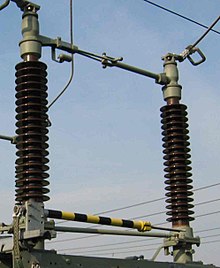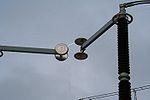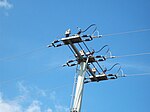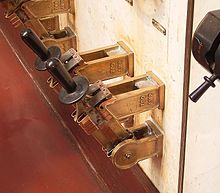Disconnector

A disconnect switch , including separators called, is an electric high-voltage switch with no requirement for the switching capacity , but with clearly visible switch position. In electrical energy technology , a conceptual distinction is made between the process of disconnection , the disconnection of electrical system parts that are currently drawing (almost) no power, and switching , i.e. switching electrical loads on and off.
A disconnector must have switching fault protection which prevents accidental opening and closing under high loads. In the event of a disconnection process under load, a disconnector would be destroyed due to the arcing fault that occurs. To switch off the electrical connection under load, circuit breakers or switch disconnectors with sufficient short-circuit power are required, which are usually combined in series with the disconnector in switchgear .
Areas of application
Applications of circuit breakers are
- the creation of a visible separating distance between live and isolated system parts,
- the implementation of the uninterrupted busbar exchange of system and line outlets.

Disconnectors for high and extra high voltage are found in outdoor switchgear and are usually operated by a motor. They are available in different designs, for example as lever separators, rotary separators, pantograph separators or gripper separators. The closing or opening process of an isolating switch takes place with the load switch open, i.e. without operating current. The comparatively weak arc that occurs between the contacts when the isolating switch is actuated is a consequence of the capacitive reactive currents of the short, unloaded line section. In an open design in outdoor switchgear in the extra-high voltage range, this arc leads to loud noise and high-frequency interference when actuated, the effects of which are compensated for within the framework of electromagnetic compatibility .
In encapsulated and gas-insulated switchgear , disconnectors are combined with other elements such as busbars, circuit breakers and measuring devices in a switch panel and are no longer directly perceptible from the outside as an independent unit.
In the medium-voltage network , disconnectors can also be found on masts in the form of mast disconnectors and are often manually operated from the ground using a mechanical linkage. A padlock protects against unauthorized use. A special design of disconnectors in medium-voltage networks is the break switch for the selective separation of individual segments in the event of a fault.
- Designs
history
The forerunners of the disconnectors are the so-called knife switches, which are among the simplest in terms of structure and the first electrical switches towards the end of the 19th century. Among other things, they were mounted on porcelain switchboards in power station control rooms and are characterized by an open design in which the electrical contacts are freely accessible.
With knife switches, the switching contacts are operated by hand using an insulated handle. Since knife switches and disconnectors do not have any devices for extinguishing the arc, they can only be used to separate comparatively small currents. During the separation process, the contacts should be moved from one position to the other as quickly as possible in order to keep contact wear to a minimum. The open design of the switch and the exposed contacts pose a great risk to the operating personnel if they are careless, which is why knife switches are no longer used at higher operating voltages.
literature
- Adolf J. Schwab: Electrical energy systems - generation, transport, transmission and distribution of electrical energy . Springer, 2006, ISBN 3-540-29664-6 .
Web links
- Switches in high voltage systems
- MPEG video ( MPG ; 1.6 MB) of a critical opening process on a 500 kV rotary disconnector, which incorrectly interrupts the reactive current of an approx. 150 km long and unloaded overhead line. The cause is a defective circuit breaker, to the right of the isolating switch, which has not previously opened completely. During the opening process, there is initially a horizontal flashover on the defective circuit breaker and, as a result, an arc of more than 40 m between the contacts of the rotary disconnector.
Individual evidence
- ↑ Max Rech, VDE (ed.): ZIPP, the electrical engineering . 6th edition. CA Weller, Berlin 1940, p. 540-552 .



